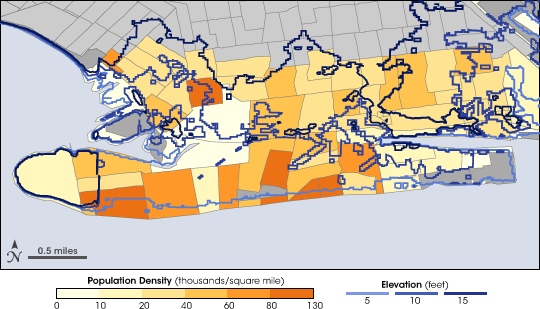

Weathering Climate Change | |||
Higher sea levels could send the cost of natural hazards soaring by increasing the hazard of flooding in coastal regions, especially if urban development and land clearing in coastal areas and flood plains increase. In such conditions, smaller storms could cause the same amount of damage as large storms have in the past, and large storms become even more devastating. In densely populated coastal regions, built to withstand the storms and floods of the past, the problem has the potential to be serious. “The number one vulnerability of the New York region is enhanced flooding,” says Cynthia Rosenzweig. “We have a tremendous amount of vulnerable infrastructure,” she says, pointing to the region’s three major airports, which are built on drained coastal land, and Lower Manhattan, which sits at a low elevation. A single, powerful event has the potential to cost the city up to $100 billion, about ten percent of the gross regional product. The Head of Climate Impacts at NASA Goddard Institute for Space Studies, Rosenzweig led a multi-disciplinary group that evaluated the potential impact of climate change on New York City and the surrounding region. |
|||
 | |||
In their evaluation, Rosenzweig and the team of geographers, geologists, economists, and others analyzed past climate trends, current response to extreme events, and predictions of what the climate may be in the future. After correcting for the city’s “heat island” effect (in which loss of natural vegetation can increase urban temperatures by six to eight degrees Fahrenheit relative to surrounding suburban and rural areas), the scientists found that New York has warmed by more than 1 degree Celsius since 1900. They also found “indication of greater variability of droughts and floods,” says Rosenzweig, though there is no clear trend yet. In the future, the group expects warmer temperatures and possibly more extreme droughts and floods. To determine how these changes might impact the New York Metropolitan Region, the team looked at how the region responded to disasters in the past. They then predicted how things like public health, water supplies, and energy demand could be affected based on climate predictions and past climate trends. The group took their findings to decision makers who will likely have to deal with climate change to show them how their responsibilities might change. This bottom-up approach to climate change—starting with first responders instead of high-level government officials— Rosenzweig hopes, will help regions prepare for extreme events now and climate change in the future. “With the greenhouse gases we have already emitted into the atmosphere, we will have climate change, but it’s uncertain how much,” says Rosenzweig. One thing she is certain of is the need for preparation. “We’re building infrastructure now that needs to withstand a change in climate. We need to think about it now.”
|
Like many coastal cities worldwide, New York is threatened by sea level rise. Densely populated neighborhoods are adjacent to the coast. This map shows the population density and coastal topography of Coney Island. Each contour (light-blue to dark blue) represents a five-foot change in elevation. Even with a modest sea level rise of 1.5 feet, the frequency of flooding will increase greatly. (Map adapted from Climate Change and a Global City) | ||